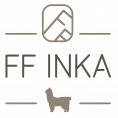Shearing and fibre harvest
Shearing is the process to cut the fleece of the Alpaca with scissors or a machine, taking the whole fleece in one piece. Domestic alpacas, unlike their wild siblings, have lost the ability to shed their wool naturally with changing seasons. Therefore, to support the animal, when winter fades, their human families shear them.
Unlike their siblings the wild vicuña and the common lama, which feature both under coat and upper coat wool, alpacas have a much finer, homogenous type of wool which is used to create wool products of extraordinary quality. Alpaca fleeces for instance are naturally resistant against rain, breathable and protect from the heat of the sun and the cold of the mountain. Woven into thick ponchos they protect people in Andean communities from the extreme weather conditions they are facing.
Shearing has the following benefits: it improves the welfare of the animal by avoiding overheating, removes the chances of insects infesting the wool during the warmer months and it allows better assessment of overall condition of the body animal, for the inspection of the skin condition and for a more effective treatment of parasites such as alpaca mites if required.
Alpacas must be sheared annually, and this happens usually in late spring, just before summer, avoiding discomfort for changes temperature. The alpaca fleece grows continuously and by the end of autumn will have grown back to a substantial thickness protect the animal through the harsh Andean winter.
Shearing is typically done by two people. Because of the status that Alpacas have within their human families they are very familiar with their caretakers and the whole process is entirely free of stress for the animal. The two people sheer the animal together. The shearing is done starting from the belly of the animal over to the back and then continuous on the other side again from belly to back to get of the fleece in one piece. One of the handlers tenders the head of the Alpaca and the hair right on the head is left out to reduce the distress for the animal even further. A skilled shearer finishes the process in within only 5 – 6 Minutes.

